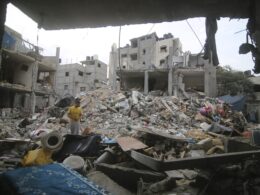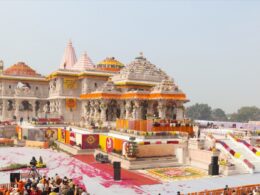As the food waters recede after the worst monsoon flooding in Pakistan’s history, up to 20 million people are beginning to come to terms with the disaster and pick up the pieces of their shattered lives. The death toll from the initial flooding belies the scale of the disaster. While 1,600 lives were lost directly, now cholera, diarrhoea and other diseases hover menacingly over the victims, putting tens, if not hundreds of thousands more at risk of death, particularly the young and the elderly.
The scale of this disaster is hard to comprehend. The affected area comprises a landmass the size of Italy. Nine million acres of arable land, the country’s breadbasket, has been submerged and the fear is that most of this land will not be suitable for harvesting until the 2012 season. Parts of the country have been literally washed away. The information minister of Khyber Pakhtoonkhwa Mian, told reporters that, “the infrastructure of this province was already destroyed by terrorism. Whatever was left was finished off by these floods”.
A nightmare future faces Pakistan’s rural population, many of whom are little more than serfs. Agriculture accounts for 21% of GDP and engages 45% of the labour force. Pakistan ranks in the world’s top five producers of onion, chickpea, apricot, cotton, sugarcane and milk. It is the world’s 9th largest wheat producer. Along with the drought in Russia, which has destroyed 25% of the wheat crop, this disaster can have world implications, driving the price of wheat through the roof, and possibly igniting food riots like those which took place across the globe two years ago
Power vacuum
But it is not just people’s lives that have disappeared with the flood waters. Gone too is the relative “stability” in the country and region. This “stability” reflected more the mutual weaknesses of the various contending forces, and their inability to offer a way out of the quagmire of poverty. Now, the disaster has opened a huge power vacuum which threatens to throw Pakistan and with it, the entire region into a tailspin of instability and violence, as all these forces survey the scene looking for an opportunity to enhance their position.
This vacuum has been demonstrated clearly on the issue of aid response. The slow sluggish response from all sides demonstrates their inertia and paralysis in the face of the disaster. Weeks passed before the pledges came in from the “international community”, and when it did, it was pitiful in face of the enormous catastrophe facing those affected. To date, $800 million has been pledged in aid, whereas the total cost is estimated to be $6 billion.
“Britain leads the way”, trumpeted the BBC. US Special Envoy to Afghanistan and Pakistan, Richard C. Holbrooke went one step further: “The people of Pakistan will see that when the crisis hits, it’s not the Chinese. It’s not the Iranians. It’s not other countries. It’s not the E.U. It’s the U.S. that always leads.” But requests for the US to hand over its military base in Sindh province to act as an emergency disaster relief centre were quietly rejected. Similarly, the $150 million pledged in aid by Washington is equivalent to two months military aid Pakistan receives from the same source.
But the response of the government has been equally exposed. In the first weeks, as the flood waters rose relentlessly, President Zardari decided his services were best served on a Grand Tour of Europe, stopping off at a French château, rather than leading the emergency response. Even George Bush thought it advisable to pay a visit to New Orleans in the aftermath of Hurricane Katrina. The anger and frustration of ordinary people was demonstrated on Zardari’s tour, when an elderly Pakistani exile in Birmingham threw his shoes at the president.
As Minister for Investments in the 1980s, Zardari became known as “Mr. 10%”, a reference to the “fee” he expected for every project he gave the green light to. Zardari is now known as “Mr. 110%”.
So discredited is the government that talk about the prospect of a military coup has grown in the aftermath of the flooding. A leader of the MQM Islamic party called for the head of the army, Ashfaq Kayani, to take on the role of “a 20th century De Gaulle … to hold the country together [and] to overcome the worst period of instability since 1947.”
Threat of military coup
This is not idle speculation. The military has always occupied a unique position in Pakistan. It is the 8th largest army in the world and for half of its existence, the country has been ruled by military decree. The military itself is said to directly control 8% of the country’s GDP and Kayani has also just been appointed to a second term.
The instability unleashed by the flooding threatens the cohesiveness and unity of the country, encouraging ethnic and religious tensions to rise. On 3 September, a Taliban suicide bomber killed 54 people in Quetta, two days after another bomb had killed 33 in Lahore. The question is clearly posed, will the military stand by as the country drifts towards division and eventual breakup.
Region destabilised
The floods also have regional implications. In July, Kayani met Afghan president Hamid Karzai in Kabul. This was an important event. After nearly a decade out in cold in Afghanistan, the Pakistan military elites saw an opportunity to re-establish their influence in the country. After the fall of the Taliban, Pakistan’s services in Afghanistan were no longer required by the US forces. Instead India, Pakistan’s fiercest rival, moved in to fill the position.
Pakistan was left to helplessly look on as India pumped $1.3 billion into Afghanistan. The Pakistan military were not prepared to allow Indian influence in the region to grow at their expense. In order to keep their interests alive, the Pakistan military elite, via the notorious secret service, the ISI, kept the Taliban alive and kicking. This is nothing new. In the 1980s and early 90s, Pakistan facilitated and nurtured Islamic fundamentalist organisations as a useful proxy for its own interests as the western backed Taliban drove the Soviet army out of Afghanistan, and Islamic terrorist groups bogged down one million Indian troops in Kashmir. The ISI also gave refuge to Taliban leader Mullah Muhammed Omar and put him up in a safe house in Quetta when he was forced to flee Afghanistan in 2001. A report from the Carr Centre for Human Rights, based on interviews with ten former senior Taliban commanders claimed the ISI “orchestrates, sustains and strongly influences” the Taliban. It is even suggested that the ISI is represented on the Taliban’s supreme leadership council!
Just like Frankenstein, the monster has turned on its benefactor and creator. The ISI now admit that Islamic fundamentalist groups pose a bigger security threat than India. In 2009, there were 87 suicide attacks which killed over 3,000 people. 1,500 Pakistani troops have been killed in the FATA areas (Federally Administered Tribal Areas) fighting Taliban troops. Even the head-quarters of the ISI has come under attack.
Hamid Karzai, his government plagued by corruption and nepotism, knows his days are numbered. In a last ditch attempt to save his skin, he has courted the help of the Pakistan military to feel out whether a compromise with the Taliban is possible. Likewise India sees its own position diminished by these moves and is seeking to reform the Northern Alliance. All this jockeying and manoeuvring threatens an escalation of violence and conflict in Afghanistan which could split the country in two and spill into the wider region.
“On the brink of collapse”
All this takes place against the backdrop of the world economic crisis. Former Commerce Minister, Hafeez Pasha decried, “Pakistan is on the brink of economic collapse.” Growth could sink from 4% to zero this year and inflation could jump from 9.5% to 18-20%. The numbers living below the poverty line has risen from 33% to 40%. As the Financial Times put it, “Always a barometer of Pakistan’s febrile political condition, foreboding has intensified over the prospect of an impending military coup, a bloody revolution and parts of the country spinning out of control.”
But none of these disaster outcomes are inevitable or even the most likely. The economic crisis, alongside the growing anger and disillusionment with the government, has awoken the Pakistani working class into action. On 16 August, 26,000 telecom workers took all out indefinite strike action demanding a 50% pay increase. Despite intimidation by management, the strike is rock solid. Similarly, this year also saw the launch of the Progressive Workers’ Federation of Pakistan, a new trade union federation bringing together 500,000 workers.
The Socialist Party’s sister party, the Socialist Movement Pakistan (SMP), has been to the fore in both these issues, arguing for a socialist alternative and assisting workers and the rural poor to get organised. Indeed, the flood disaster has exposed in the ability of capitalism to deliver a decent future for the masses of Pakistan and the region as a whole. As Leon Trotsky pointed out 100 years ago, the capitalist class in an under-developed, backward country like Pakistan could never bring society up to the level of the advanced capitalist countries in the West. They are incapable of doing this because they are tied by a thousand strings to the interests of imperialism and landlordism.
So it falls to the working class to lead society out of the morass of poverty and oppression. But in doing so, the working class will come up against the interests of the feudal landlords, the local Pakistani capitalist class and imperialism itself. Therefore it will be necessary to fight for the socialist transformation of society. This is the only way feudalism, poverty and oppression can be ended.
TRADE UNION RIGHTS CAMPAIGN PAKISTAN
Make out cheques & lodgements to:
“Pakistan Appeal”
A/C 00452073
Sort code 931209
AIB Dame Street, Dublin 2














